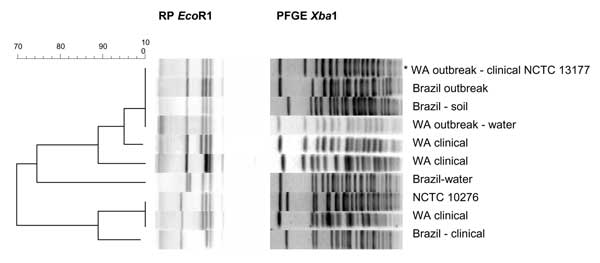Volume 11, Number 9—September 2005
Dispatch
Melioidosis, Northeastern Brazil
Figure A1

Figure A1. . Molecular typing results for Burkholderia pseudomallei isolates from Brazil compared with Western Australian and reference isolates. The Unweighted Pair Group Method using arithmetic averages dendrogram on the left refers to the EcoR1 ribotype patterns in the center. XbaI DNA macrorestriction (pulsed-field gel electrophoresis, PFGE) patterns are shown at the right of the corresponding ribotypes for comparison. The ribotypes and PFGE types are each numbered from the first lane at the top of the figure, increasing by one for each new type. PFGE types were allocated numbers independently of ribotypes.
Page created: April 23, 2012
Page updated: April 23, 2012
Page reviewed: April 23, 2012
The conclusions, findings, and opinions expressed by authors contributing to this journal do not necessarily reflect the official position of the U.S. Department of Health and Human Services, the Public Health Service, the Centers for Disease Control and Prevention, or the authors' affiliated institutions. Use of trade names is for identification only and does not imply endorsement by any of the groups named above.